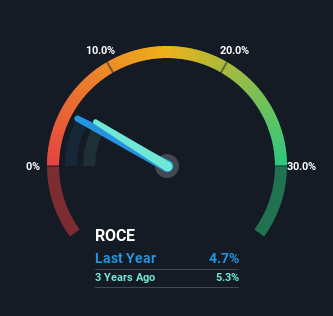- United Kingdom
- /
- Consumer Durables
- /
- AIM:VCP
Victoria (LON:VCP) Might Be Having Difficulty Using Its Capital Effectively

If you're not sure where to start when looking for the next multi-bagger, there are a few key trends you should keep an eye out for. Typically, we'll want to notice a trend of growing return on capital employed (ROCE) and alongside that, an expanding base of capital employed. This shows us that it's a compounding machine, able to continually reinvest its earnings back into the business and generate higher returns. In light of that, when we looked at Victoria (LON:VCP) and its ROCE trend, we weren't exactly thrilled.
Return On Capital Employed (ROCE): What Is It?
If you haven't worked with ROCE before, it measures the 'return' (pre-tax profit) a company generates from capital employed in its business. The formula for this calculation on Victoria is:
Return on Capital Employed = Earnings Before Interest and Tax (EBIT) ÷ (Total Assets - Current Liabilities)
0.047 = UK£71m ÷ (UK£2.0b - UK£501m) (Based on the trailing twelve months to October 2022).
So, Victoria has an ROCE of 4.7%. Ultimately, that's a low return and it under-performs the Consumer Durables industry average of 13%.
See our latest analysis for Victoria

In the above chart we have measured Victoria's prior ROCE against its prior performance, but the future is arguably more important. If you'd like to see what analysts are forecasting going forward, you should check out our free report for Victoria.
What Does the ROCE Trend For Victoria Tell Us?
Unfortunately, the trend isn't great with ROCE falling from 12% five years ago, while capital employed has grown 497%. Usually this isn't ideal, but given Victoria conducted a capital raising before their most recent earnings announcement, that would've likely contributed, at least partially, to the increased capital employed figure. Victoria probably hasn't received a full year of earnings yet from the new funds it raised, so these figures should be taken with a grain of salt.
In Conclusion...
In summary, despite lower returns in the short term, we're encouraged to see that Victoria is reinvesting for growth and has higher sales as a result. However, despite the promising trends, the stock has fallen 33% over the last five years, so there might be an opportunity here for astute investors. As a result, we'd recommend researching this stock further to uncover what other fundamentals of the business can show us.
Victoria does come with some risks though, we found 3 warning signs in our investment analysis, and 2 of those shouldn't be ignored...
If you want to search for solid companies with great earnings, check out this free list of companies with good balance sheets and impressive returns on equity.
New: Manage All Your Stock Portfolios in One Place
We've created the ultimate portfolio companion for stock investors, and it's free.
• Connect an unlimited number of Portfolios and see your total in one currency
• Be alerted to new Warning Signs or Risks via email or mobile
• Track the Fair Value of your stocks
Have feedback on this article? Concerned about the content? Get in touch with us directly. Alternatively, email editorial-team (at) simplywallst.com.
This article by Simply Wall St is general in nature. We provide commentary based on historical data and analyst forecasts only using an unbiased methodology and our articles are not intended to be financial advice. It does not constitute a recommendation to buy or sell any stock, and does not take account of your objectives, or your financial situation. We aim to bring you long-term focused analysis driven by fundamental data. Note that our analysis may not factor in the latest price-sensitive company announcements or qualitative material. Simply Wall St has no position in any stocks mentioned.
About AIM:VCP
Victoria
Designs, manufactures, and distributes flooring products primarily in the United Kingdom, Italy, Belgium, Spain, Australia, the Netherlands, Turkey, France, Ireland, Portugal, and the United States.
Undervalued slight.
Similar Companies
Market Insights
Community Narratives




